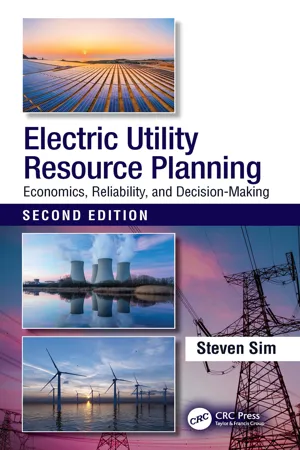
Electric Utility Resource Planning
Economics, Reliability, and Decision-Making
- 413 pages
- English
- ePUB (mobile friendly)
- Available on iOS & Android
About this book
In 2012, using easy-to-understand text and examples, the first edition of this book explained how electric utilities "work," and how they plan (or should plan) for the future, by:
- "Creating" a hypothetical electric utility
- Explaining how (and why) this utility will operate its system of generating units
- Guiding readers through a planning analysis for the utility, examining various resource options (solar, new gas-fueled generation, and conservation)
- Introducing four Fundamental Principles of Resource Planning that should guide utilities as they plan for the future
The first edition material, with significant updates, now appears as Part I of the second edition of this book. Part II of this book then presents six all-new chapters that address the challenges (and opportunities) of moving toward a zero-carbon future. Using the same hypothetical utility, with its new goal to utilize solar and batteries to serve 100% of its customers' energy with zero carbon emissions by a future "target"year, Part II of this book addresses many subjects, including:
- The enormous amount of MW of new solar and batteries the utility will need to add
- Why certain characteristics of new solar and battery additions change as increasing amounts of these resources are added
- In the years prior to achieving its zero-carbon goal, how the hourly operation of the utility's existing fossil-fueled generators, plus the new solar, will change (and why the stability of the transmission grid will be challenged)
With this second edition, author Dr. Steven Sim again applies the experience and insights he gained from more than 30 years of resource planning for Florida Power & Light (FPL). As one of the largest electric utilities in the United States, FPL has faced a multitude of resource planning challenges, including how to get to zero carbon. During this time period, Dr. Sim performed and directed thousands of analyses designed to address these challenges. He also served as an expert witness in dozens of regulatory hearings, addressing both the economics of resource options and the non-economic impacts (air emissions, system reliability, fuel usage, etc.) associated with these options.
Frequently asked questions
- Essential is ideal for learners and professionals who enjoy exploring a wide range of subjects. Access the Essential Library with 800,000+ trusted titles and best-sellers across business, personal growth, and the humanities. Includes unlimited reading time and Standard Read Aloud voice.
- Complete: Perfect for advanced learners and researchers needing full, unrestricted access. Unlock 1.4M+ books across hundreds of subjects, including academic and specialized titles. The Complete Plan also includes advanced features like Premium Read Aloud and Research Assistant.
Please note we cannot support devices running on iOS 13 and Android 7 or earlier. Learn more about using the app.
Information
Table of contents
- Cover Page
- Half-Title Page
- Title Page
- Copyright Page
- Contents
- Acknowledgments
- Author
- Part I The Fundamentals of Electric Utility Resource Planning
- Part II Moving toward Zero Carbon
- Appendix A: Fundamental Principles of Electric Utility Resource Planning
- Appendix B: Glossary of Terms
- Appendix C: Mini-Lesson #1: Concepts of Revenue Requirements, Present Valuing of Costs and Discount Rates, Cumulative Present Value of Revenue Requirements, and Levelized Costs
- Appendix D: Mini-Lesson #2: Further Discussion of the Limitations of a Screening Curve Analytic Approach
- Appendix E: Mini-Lesson #3: Further Discussion of the RIM and TRC Preliminary Cost-Effectiveness Screening Tests for DSM
- Appendix F: Mini-Lesson #4: How Can a Resource Option Result in Lower Costs but Increase Electric Rates?
- Appendix G: Mini-Lesson #5: How Can a Resource Option That Produces Emissions Result in Low Utility Total System Emissions? (“The Taxi Cab Example”)
- Index